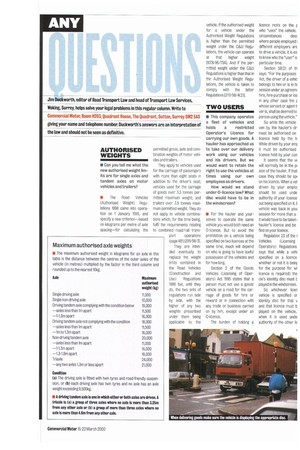AUTHORISED WEIGHTS
Page 55

If you've noticed an error in this article please click here to report it so we can fix it.
• Can you tell me what the new authorised weight limits are for single axles and tandem axles on motor vehicles and trailers?
• The Road Vehicles (Authorised Weight) Regulations 1998 came into operation on 1 January 1999, and specify a new criterion—based on kilograms per metre of axle spacing—for calculating the permitted gross, axle and combination weights of motor vehicles and trailers.
They apply to vehicles used for the carriage of passengers with more than eight seats in addition to the driver's seat; vehicles used for the carriage of goods over 3.5 tonnes permitted maximum weight; and trailers over 3.5 tonnes maximum permitted weight. They do not apply to vehicle combinations which, for the time being, fulfil the requirements relating to combined road/rail trans port operations (page 461) (311V98/3).
They are intended eventually to replace the weight limits contained in the Road Vehicles (Construction and Use) Regulations 1986 but, until they do, the two sets of regulations run side by side, with the higher of any two weights prescribed under them being applicable to the vehicle. If the authorised weight for a vehicle under the Authorised Weight Regulations is higher than the permitted weight under the C&U Regulations, the vehicle can operate at that higher weight (1078/86/79A1. And if the permitted weight under the C&U Regulations is higher than that in the Authorised Weight Regulations, the vehicle is taken to comply with the latter Regulations [3111/98/4(2)].
















































































































